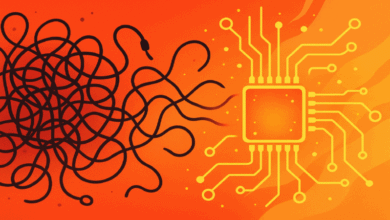AI’s Impact on Paid Media, User Behavior & Brand Visibility

▼ Summary
– AI has evolved from background optimization to powering entire campaign formats, reshaping how paid media operates.
– User behavior is shifting as consumers increasingly use AI tools like ChatGPT for research, reducing traditional ad interactions.
– Competition for ad inventory is intensifying due to fewer ad spots, raising CPCs and requiring broader channel strategies.
– The marketing funnel is flattening, with fragmented, conversational journeys that demand cross-channel visibility and attribution rethink.
– Successful adaptation requires integrating paid, SEO, and content strategies, prioritizing brand strength, and embracing AI-driven testing.
The integration of artificial intelligence into paid media is no longer a subtle enhancement, it’s a fundamental overhaul. What began as automated bidding and creative testing has evolved into a complete reimagining of how brands connect with audiences, optimize campaigns, and measure impact. AI is reshaping everything from tactical execution to user discovery patterns, forcing marketers to rethink long-held strategies and adapt to a rapidly shifting digital ecosystem.
Gone are the days when AI simply fine-tuned bids in the background. Today, it powers entire campaign formats across major advertising platforms, reducing manual effort while maximizing algorithmic testing and placement performance. Budgeting and targeting have become exponentially smarter, with systems now processing countless signals, location, device, intent, in real time, far beyond human capacity. Predictive audience models now identify entirely new user segments, offering faster and more efficient paths to scale.
Automation has also taken over repetitive tasks that once consumed hours each week. AI agents analyze search queries, detect cost-per-click trends, and flag anomalies within minutes. This shift doesn’t eliminate the need for human expertise; rather, it redefines it. Practitioners can now focus less on manual adjustments and more on high-level strategy, cross-channel integration, and customer experience. Thriving in this new landscape means working with AI, not against it.
But the changes extend far beyond the advertiser’s dashboard. User behavior is transforming in profound ways. AI Overviews in search results are compressing organic and paid listings, altering click patterns and reducing traditional visibility. More users are turning to conversational AI tools like ChatGPT and Gemini for research and recommendations, bypassing classic search engines and top-of-funnel ads. This behavioral shift means fewer ad spots, heightened competition, and rising costs, pushing brands to broaden their channel mix and strengthen overall presence.
These trends demand a fundamental rethinking of marketing strategy. The funnel is flattening; customer journeys are now fragmented, conversational, and often invisible to traditional analytics. A user might start with a broad search, refine their query through an AI chat, validate on social media, and convert via retargeting. Brands must be discoverable at every touchpoint, even those that don’t directly convert.
This new reality also blurs the lines between paid, organic, and content strategies. AI Overviews may reduce paid search traffic, making SEO and content more critical than ever. Marketers must monitor how their brand appears in AI-generated answers and adjust accordingly. Insights from large language model queries should be shared across teams to refine keyword strategies, creative messaging, and content production. Paid campaigns can amplify educational content, ensuring visibility long before a user even types a query.
Cross-channel collaboration becomes essential. Analyzing organic AI queries can improve paid ad copy; reviewing ad performance can identify high-engagement content that needs conversion optimization. These insights help create a consistent, holistic brand narrative across all touchpoints.
Key takeaways for modern marketers include crafting fluid experiences rather than rigid funnels, investing in cross-channel cohesion, and building brand authority before demand exists. Leaning into testing and adaptation is no longer optional, it’s essential for survival. Marketers who embrace AI as both an operational tool and a creative amplifier will not only keep pace but lead in this new era.
The advantage AI brings to paid media is clear: it drives efficiency, reshapes user behavior, and redefines brand visibility. This evolution is ongoing and unpredictable, but those who integrate AI thoughtfully, balancing automation with human insight, will find themselves not just adapting, but thriving.
(Source: Search Engine Land)





